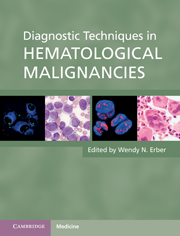1 - Morphology
from Part 1 - Diagnostic techniques
Published online by Cambridge University Press: 06 December 2010
Summary
The diagnosis of hematological malignancies has benefited enormously from recent scientific advances. In spite of this, morphology remains critically important and is the key front-line diagnostic technique which must not be overlooked. The light microscopy appearances may be diagnostic but, in addition, they are the foundation upon which decisions about further scientific assessment are based. In the modern era that utilizes a multi-parameter approach to disease classification, morphology is the screening test that determines the further investigations necessary. This opening chapter describes the principles of morphological assessment of the blood and bone marrow in the diagnosis, staging and monitoring of hematological malignancies. It will guide the reader through the process of blood and bone marrow microscopy and demonstrate how morphology alone can often give an indication of the underlying diagnosis. The chapter is not intended as a textbook or atlas of hematological neoplasms; for this, the reader is referred to one of numerous excellent monographs and atlases.
Peripheral blood
Abnormalities on a blood count, be they quantitative or qualitative, may be the first indication of a hematological malignancy and will generally lead to a blood film being examined. Whereas currently this is most commonly performed by light microscopy, automated image capture methods are increasingly being used. It is recommended for the assessment of neoplastic cells that morphological review be performed manually as a well-trained pair of eyes is more discriminating than a programmed computer.
- Type
- Chapter
- Information
- Diagnostic Techniques in Hematological Malignancies , pp. 1 - 27Publisher: Cambridge University PressPrint publication year: 2010
References
- 1
- Cited by



